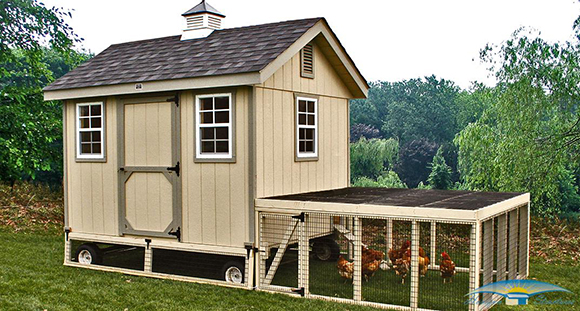How To Select The Best Chicken Coop
By Nikki Alvin-Smith

What comes first, the chicken or the coop? As chicks need to be kept warm for the first few months of life, most owners opt to keep them indoors under their watchful eye with a heat lamp if needed. So if you are just starting your adventure in chicken ownership, you can manage without a coop for the first few months of their life.
In early Spring agricultural stores and feed merchants will have plenty of chicks for sale, and if you buy a few Spring chicks each year, they should lay eggs from Fall and produce a few eggs throughout the following winter even without artificial winter light. Without 16 hours of light a day chickens won’t lay, but at least in winter the existing flock can get a rest which means more production years overall.
But the coop will certainly be needed. Here are a few tips on how to select the best chicken coop with some help from our friends:
 TV show host, blogger and 5th generation chicken keeper Lisa Steele https://www.fresheggsdaily.com/ You can visit this website for answers on a myriad of chicken questions, egg recipes and learn an amazing amount about how to enjoy the most from owning your own flock of chickens.
TV show host, blogger and 5th generation chicken keeper Lisa Steele https://www.fresheggsdaily.com/ You can visit this website for answers on a myriad of chicken questions, egg recipes and learn an amazing amount about how to enjoy the most from owning your own flock of chickens.
 Rachel Miller, chicken coop specialist at one of the nation’s leading manufacturers of chicken coops, Horizon Structures.
Rachel Miller, chicken coop specialist at one of the nation’s leading manufacturers of chicken coops, Horizon Structures.
The most common question Miller is asked by a prospective coop purchase is what size coop they should buy.
“The general rule is 5 chickens per nest box, but that can vary depending on size of the actual coop. At Horizon Structures we offer every possible type and style of chicken coop, from pull-along tractor coops you can move around the field to coops with enclosed runs to high-end designer series like the Lisa Steele Coop. Our most popular style is the Quaker Coop as it gifts great value for money, and we offer super coops that house up to 40-45 hens. Obviously everyone has a different budget, so I send them a price sheet that includes all the options so they can get a good handle on what costs what and decide what they need versus what they want.”
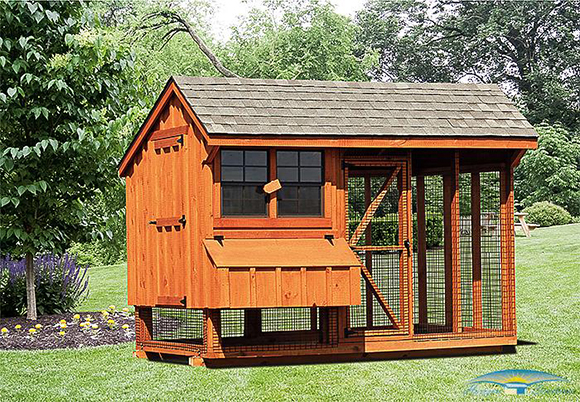
Obviously coops can be designed to complement existing structures on your property in roof design, siding and color. A full range of customization choices to suit your individual preferences and price point, makes working directly with an experienced manufacturer a smart decision. The final product can be delivered on site with the minimum of fuss, the entire buying process is fun.
“It is important to consider the daily routines and cleaning rituals that are involved in keeping chickens. When we design our coops our utmost consideration is the health and safety of the flock, and we incorporate many features to maximize the health and hygiene of the chickens. For example, while a wooden floor in a chicken coop can suffice, our coops come with an epoxy sealed floor. This means the clean up is not only easier, it is more effective,” Miller stated.
Cashing in on the knowledge of an experienced coop building company staff, can also yield answers to questions you didn’t know you needed to ask. Here’s some more things to consider.
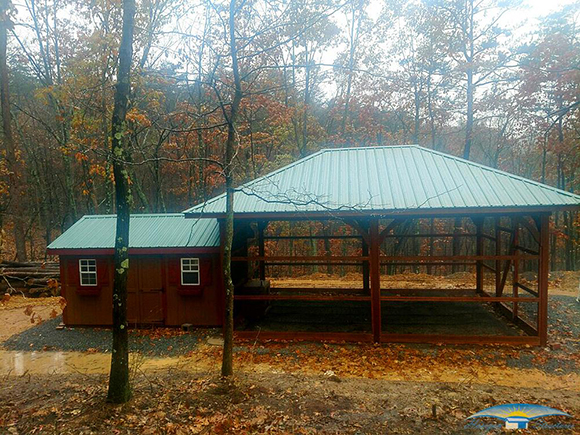
Birds of prey and interference from other predators such as coyote, foxes, weasels and snakes are always a concern. The decision to add a run to a coop under a porch can be beneficial to protect the chickens from aerial attack and nefarious critters digging under fence lines. The ultimate welfare of the chickens is in your hands, and the happier they are the better they will produce.
Methods that good coop designs employ to keep the predators at bay include raising the coop 12” to 14” off the ground, adding chewproof vinyl coated metal mesh over windows, strong and secure doors, windows and metal vents and thick siding.

The quality of materials and craftsmanship are essential components in any structure and the chicken coop is no different. Raw materials need to be suited to a wide range of weather and climate conditions.
Miller explained that Horizon Structures Amish chicken coops are housing backyard chickens in 46 states. Here are key features to look for that come standard in their coops and further customizations, such as automatic doors can be added.
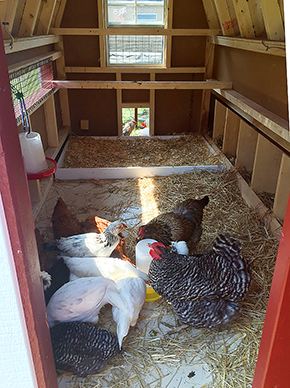 Siding: white pine board and batten (clear or cedar stain) or LP SmartSide (painted: you choose the colors!) BOTH are superior wood products offering natural insulating properties (for both heat and cold) as well as standing up to whatever Mother Nature can throw at them year after year.
Siding: white pine board and batten (clear or cedar stain) or LP SmartSide (painted: you choose the colors!) BOTH are superior wood products offering natural insulating properties (for both heat and cold) as well as standing up to whatever Mother Nature can throw at them year after year.
Solid wood rafters: create a super-strong roof to hold up heavy winter snow loads.
Generous windows: let light in while keeping wind and rain out. The metal framing is chew-proof and resistant to rust.
Venting: allows heat and moisture to escape while keeping rain, snow and drafts out of the coop. Some coop models have extra-large hinged panels allowing you to open the vents in order to maximize air-flow on hot, sunny days.
Foundation: pressure-treated wood resists moisture and insect damage. Our elevated chicken coop models provide a shady spot for the hens to rest underneath AND keep the coop interior drier and cooler in summer.
Weather can also be a factor in the health of the chickens, and while folks are quick to believe that some form of heat should be provided within the coop, many experts disagree. While Horizon Structures does offer heat sources built into a coop, such as heated roofs, natural heat is the recommendation of Lisa Steele:
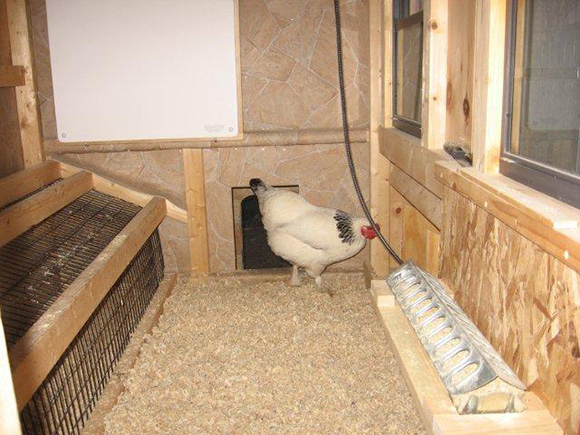
“While it seems natural to worry about your chickens in the winter, they're actually far more comfortable in the cold than you might imagine. Even here in Maine, our chickens do just fine when there's snow on the ground and it doesn't get above freezing for days on end. They do however, appreciate a little bit of TLC to get them through it.”
According to Steele, four things that are important to help your chickens when the temperatures drop include:
1. Deep litter bedding in a dry, well ventilated coop that allows moisture and ammonia to escape. A bed of straw is perfect.
2. Outdoor perches and wind blocks to encourage your flock to spend as much time outside as possible. The perches entice them to get outside as chickens dislike walking on muddy and frozen ground. You can spread straw outside to protect their feet and as chickens also dislike wind, wrapping part of their enclosure in a tarp can help provide a wind block.
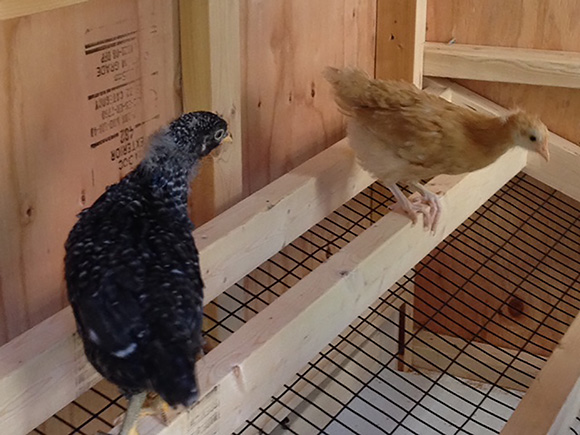
3. Scratch grains and suet provided at bedtime helps keep your chickens warm at night.
4. Fresh and unfrozen water is essential and needs to be provided 24 hours a day. To keep it from freezing explore the use of an electric dog bowl.
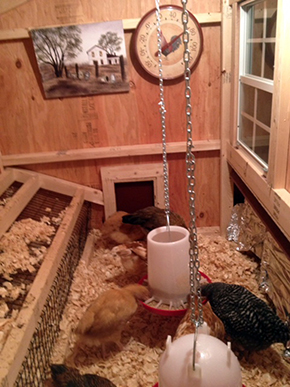 When you think about all birds, they keep warm by fluffing their feathers. So if you’ve provided them with a deep, dry bed of straw and follow Steele’s advice, you should be good to go and avoid the risk of fire from heat lamps. The size of the coop relative to the number of chickens is also important, as too few chickens in too large a coop won’t provide enough body heat to keep themselves warm.
When you think about all birds, they keep warm by fluffing their feathers. So if you’ve provided them with a deep, dry bed of straw and follow Steele’s advice, you should be good to go and avoid the risk of fire from heat lamps. The size of the coop relative to the number of chickens is also important, as too few chickens in too large a coop won’t provide enough body heat to keep themselves warm.
Horizon Structures offer coops with roughed in electrical packages with a light switch and outlet availability. The circuit(s) is conveniently tailored to an outside junction box to make plugging in an extension cord easy.
Delivery and set up of a coop is a simple process. Miller explained the math:
“We can place a coop pretty much anywhere, with the use of our ‘mule’ system. Clearance wise for access we need just two feet of clearance around the perimeter of the coop. For larger coops we recommend a stonedust pad be completed so the coop can be placed level. Our coops come on runners, so they can easily be moved if necessary.”
You might wonder what’s new in the chicken coop business. Owner at Horizon Structures Dave Zook did literally write the book on building chicken coops (Building Chicken Coops for Dummies), but that doesn’t mean that improvements aren’t constantly being made to their product line.
“Our tractor coops now offer a hydraulic wheel system. Their coop box plus run combination is now easier than ever for one person to move around. A simple lever pops the wheels and lifts the coop ready for moving to the next area. This saves a lot of trouble hitching up a tractor or ATV to move the coop and customers love it,” said Miller.

Of course whether you are new to being a chicken keeper or an experienced chicken aficionado, luxury features are always interesting to consider.
“There are many options available an the most popular ‘luxury’ feature is probably our automatic chicken doors that close and open on whatever schedule you set up for dawn and dusk timing. We even have an advanced system that is connected via GPS to sunrise and sunset so you don’t have to think about resetting the timer as seasons change. These doors operate off battery or via electrical systems.
Other features to think about are the cleaner trays. These simple slide in and out of the coop for the most efficient and easy clean ever. They catch the manure, pull them out, hose them off and slide them back in. Then there’s our eco-friendly solar package that can provide electricity and light. Outside the coop additions such as cupolas can benefit the occupants by adding ventilation and a pleasing aesthetic appeal to the structure.”
For more information on the beautifully crafted Amish chicken coops please don’t hesitate to reach out to Rachel Miller on 1-888-447-4337.
